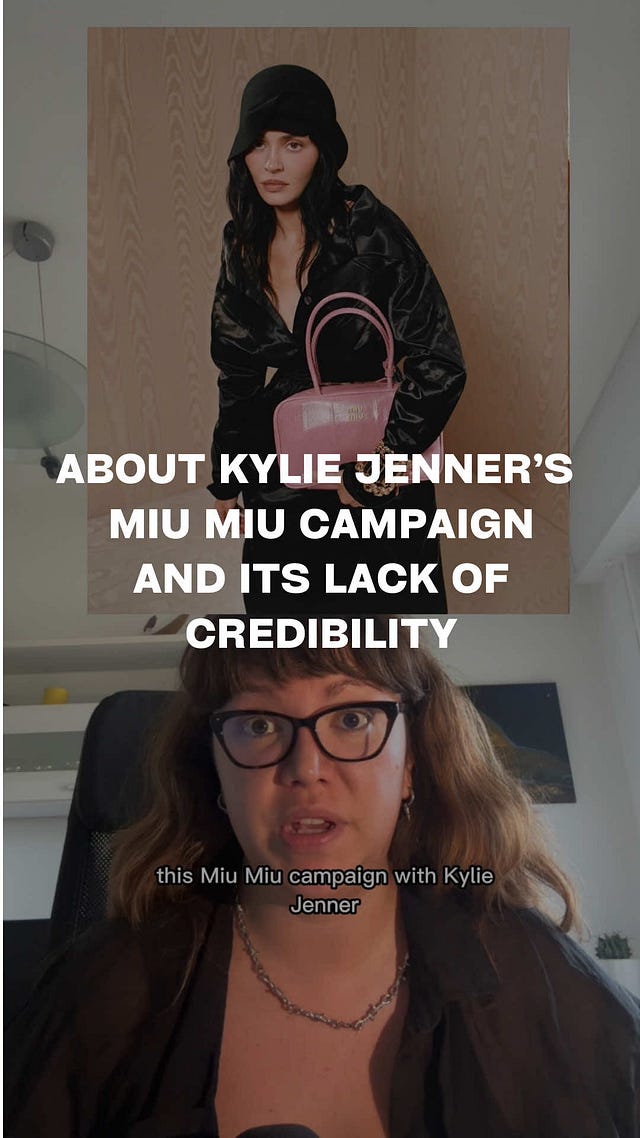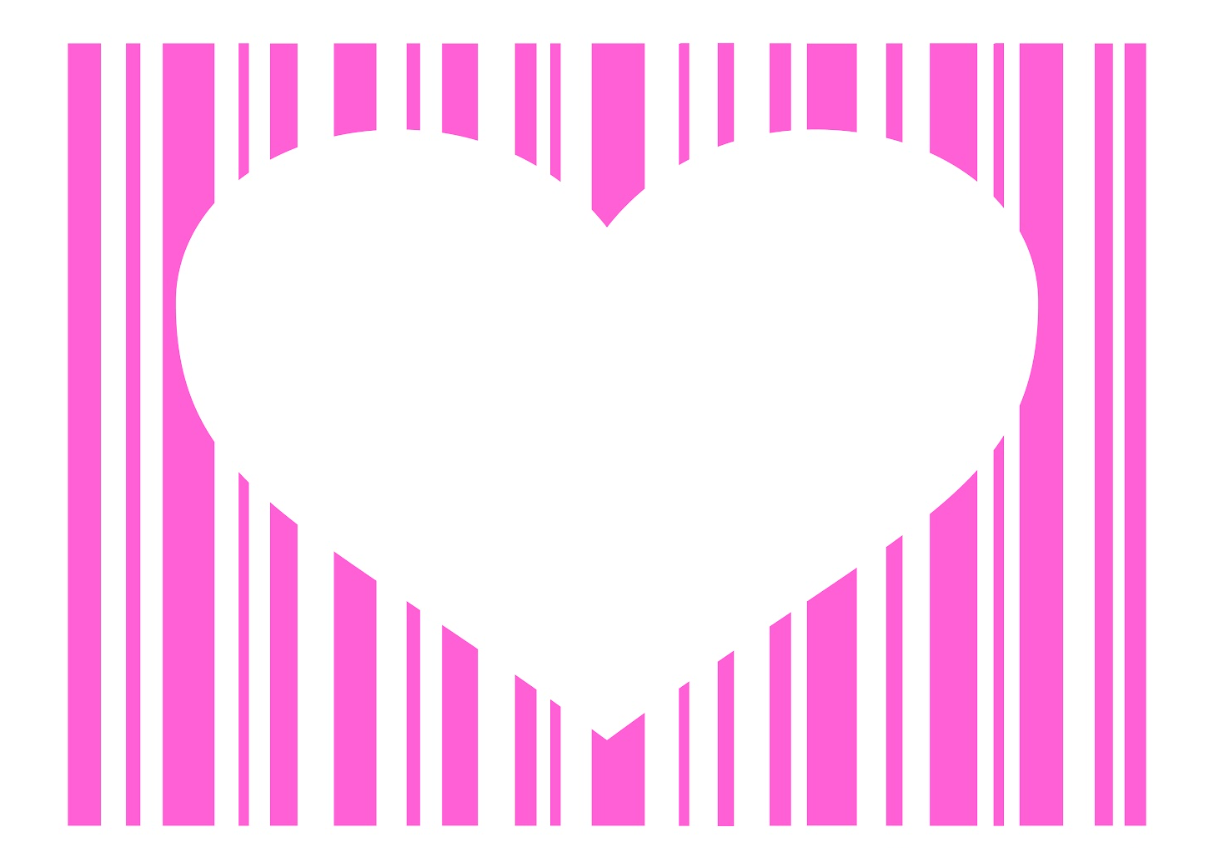The fashion simulation is glitching
As symbols lose meaning and subversive codes go mainstream, luxury’s carefully crafted illusions are starting to fray.
This week’s upload is about breakdowns – in aesthetic codes, creative labour and the symbols in luxury that once held weight. From Kylie Jenner’s casting in a brand built on subversive femininity, to Netflix’s integration of generative AI under the banner of “empowerment,” we’re watching value shift and credibility slip. Meanwhile Loro Piana’s supply chain scandal exposes the gap between narrative and reality, and Eugene Rabkin’s take on post-Baudrillard fashion lands uncomfortably close. If the simulation no longer holds, what comes next?
As always, everything’s filed by code.
What we wear and what it says about our values, identities and roles.
Is Kylie Jenner a Miu Miu girl?
The internet has opinions about Miu Miu’s latest campaign star: Kylie Jenner. Of all the Kardashian-Jenner clan, she’s arguably the most palatable right now. People love the mommy-and-me content. The candid boob job confessions. Her British Vogue cover barely ruffled feathers. The Khy x Poster Girl collab sold out. The Coperni runway walk was widely praised. So why the outrage now?
I think this creator nailed it
“Fashion has this recurring obsession with emotional stillness: the woman who doesn’t flinch, who doesn’t speak and doesn’t react. She’s supposed to look cold and powerful and that’s the aesthetic. It’s very much engraved in brands like Miu Miu. Kylie, here, looks like she’s under some kind of anaesthesia. We’re getting nothing. It’s like she’s cosplaying Lily-Rose Depp in a world where nothing matters, which could work if there were a story behind it, but there isn’t. This aesthetic – the stoic unreadable woman – is supposed to be used on women with a context. Originally it pushed back against objectification. It suggested control mystery, even defiance, but now especially when Miu Miu decided to use someone like Kylie Jenner to portray it feels like a tired formula.”
What’s also really irking people is that her casting signals a credibility wobble. Miu Miu has spent years carefully cultivating cultural capital through a full-blown intellectual ecosystem: the Miu Miu Women’s Tales short film series, curated book clubs and an ongoing alignment with brainy, subversive femininity (it’s worth noting that the campaign also featured rapper Cortisa Star and Industry star Myha’la). For a brand that’s carefully crafted a thoughtful, layered identity, the Kylie pivot feels like a glitch in the matrix — trading substance for short-term virality.
That said, the backlash is also a weird compliment. It means Miu Miu has succeeded in doing what most brands can’t: building a world with such strong codes and such a defined archetype, that people actually care who’s allowed in. Most brands aren’t even fully formed enough to cast wrong. Me personally, I’m a Miu Miu defender for life. Just read this or this.
The cultural norms, narratives and power structures that define what’s acceptable.
Why are we so afraid of the Gen Z stare?
It would be remiss not to talk about the Gen Z stare because apparently, it’s the one thing the internet can’t shut up about this week. A seven-second clip of a retail worker holding unbroken eye contact, blank-faced and vaguely unimpressed, has ignited yet another millennial-versus-Zoomer discourse cycle. These debates are traffic gold, which is why the media jumps on them every time. But beneath the memeification there is something real being negotiated.
The TL;DR on the Gen Z stare: it’s a neutral (read: emotionless) gaze, often wide-eyed, usually silent. It appears most often in workplace settings, especially retail and customer service, where a young worker is caught on camera reacting – or rather, not reacting – to a customer’s request. Older generations see it as passive-aggressive. Gen Z says it’s a boundary.
 Tiktok failed to load.
Tiktok failed to load.Enable 3rd party cookies or use another browser
This isn’t the first time a generational micro-expression has been memed into discourse. We’ve seen iterations of this before, most recently in the Gen Z shake versus the millennial pause, a cultural shorthand for different approaches to self-presentation on video (which I unpacked for i-D here). These debates are often framed in trivial terms, but they point to deeper distinctions in how each generation was socialised.
One popular explanation frames the Gen Z stare as a “modern freeze response” – a psychological defence mechanism in overstimulating or uncomfortable situations. Others connect it to the rise in social anxiety. But more compellingly, it denotes a learned form of self-preservation. Gen Z came of age under near-constant observation – from classroom Zoom calls to algorithmically driven social platforms – where visibility is both expected and exhausting.
To dismiss the stare as apathy is to overlook its function. Perhaps it’s not disengagement but a new language for navigating attention, visibility and emotional labour. In a culture that demands constant performance, stillness can be its own form of control. That said, I might not think that if I was on the receiving end of it.
The digital systems that shape how we interact, transact and behave.
Netflix admits it used generative AI in latest sci-fi film to cut costs
Few platforms discuss AI more obsessively than Substack, and arguably, for good reason. Nowhere is AI anxiety sharper currently than in the space of writing itself. Mass adopted tools like ChatGPT threaten the very premise of the job. I’ve seen the discourse play out across a full spectrum: moralistic, economic, defeatist even cognitive. Should we use them? Are we complicit if we do? Or simply obsolete if we don’t? This piece on how we may only have 36 months to make it before AI completely reshapes how we work is worth a read. The clock, apparently, is ticking.
My unease is only amplified by the latest Netflix news. In a first for the platform, its original sci-fi series The Eternaut used generative AI to render a collapsing building in Buenos Aires. Netflix co-CEO Ted Sarandos revealed during an earnings call that the scene was produced ten times faster than traditional VFX workflows and more importantly, at a cost that would have been "unfeasible" for a show with that kind of budget. “We remain convinced,” he said, “that AI represents an incredible opportunity to help creators make films and series better, not just cheaper.”
The language is telling. “Better, not just cheaper” frames AI as a tool for creative empowerment – but make no mistake: the driving force is efficiency. And if that framing wasn’t clear enough, Meta drove the point home. On Tuesday, the company officially snubbed the EU’s voluntary AI Code of Practice, which is a set of guardrails encouraging companies to be transparent about how their AI systems work, particularly in terms of copyright, data sourcing and synthetic content.
I’m not trying to be alarmist, but I don’t think we’re seriously preparing for what the rise of AI means for creative work. I’d love to know if you’ve been thinking about how to future-proof what you do?
The logic of consumption, capitalism and commodified desire.
Loro Piana is in hot water again
Uh oh. Loro Piana — the crown jewel of quiet luxury — has just been placed under judicial administration by an Italian court. The charge? Failing to prevent exploitative labour practices deep in its supply chain. The court didn’t accuse the brand of direct wrongdoing, but it did accuse it of looking the other way. While Loro Piana's €3,000 jackets traded on craftsmanship and heritage, the reality behind the label was far murkier: migrant workers in Italy, some undocumented, reportedly working up to 90 hours a week for €4 an hour, sleeping in the same factories where they stitched cashmere. If you can’t trust Loro Piana, who can you trust?
Is the luxury simulation over?
Loved this piece by Eugene Rabkin – any mention of Jean Baudrillard and I’m in. But this one, in particular, feels especially timely in light of everything above.
For those unfamiliar, Baudrillard’s Simulacra and Simulation is a foundational text in postmodern theory, in which he argues that we’ve entered an era where representations no longer refer back to any underlying reality. Instead, symbols begin to refer only to other symbols – a hall of mirrors where the original is irrelevant, and copies become indistinguishable from, or even more desirable than, the “real” thing. Sound familiar?
Which is why this passage from Rabkin’s article hit so hard:
“It’s not that people no longer want the symbols of luxury. But those symbols have to be grounded in great product to be believable. And if the entire luxury industry has become a simulacrum, where the symbol is hollow, there is little difference between the real and its copy.
It’s well known what one gets when one buys a superfake. It’s more interesting to consider what one doesn’t get: provenance. But if few customers seem to care, it’s because luxury’s narratives of origin and superior craftsmanship no longer seem credible.
We have reached the last stop on the simulacrum express. Can the industry find its way back to the land of the real? Making actual luxury goods and not just telling stories about making luxury goods would be a good place to start.”











Great article! I think Ai can be like car or any tool, in some way... the bad use that can be made will be made by a human user. It can be really helpful if one has it'a own boundaries on using it. I couldn't agree more with you on Miu Miu. 💌🧵
Omg yes im a miu miu apologist forever but when i opened their latest email with kylie front & centre i was like, surely i’m not the only one thinking this!